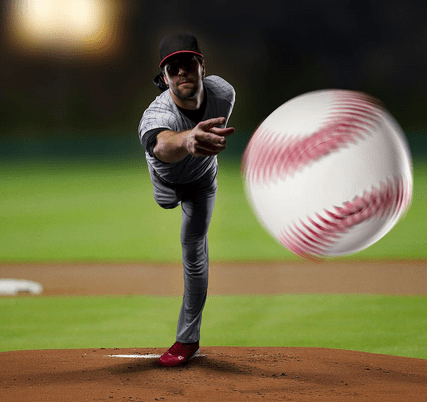The objective of the baseball game is to score more runs than the opponent team. The game lasts for Nine innings with each team. At the end of the innings, the cumulative score is determined, and the team with more points is declared the winner, but the main role in winning a game is played by the pitcher. Those who come with a mind to conquer the game design pitches as per the goal.
A baseball game starts with a pitch. It is an act of throwing the ball towards the home plate, and here the game begins. However, there are numerous types of baseball pitches a pitcher can throw. They may have a different angle, hand position, velocity or trajectory. These varying pitches make the game competitive and confuse the batter so that he may not be able to make a run and gets out. This is why it is really critical to understand the types of pitches. However, the selection of pitch depends upon various factors, including the no. of baserunners, the type of batter to be faced and the score. The action involves a lot of science, so one must learn about the type of pitches considerately if he is a baseball enthusiast.
So, in this article, we have come up with the types of baseball pitches so that you may be able to enjoy competitive play in future. Read down the lines and learn about various pitches you may encounter in the baseball game.
How to identify a pitch? – Types of Baseball Pitches

There are plenty of pitches you may need to learn about. However, every pitcher throws a certain type of pitches, so you must also research the pitcher you are going to encounter in order to predict the type of pitches he is likely to throw. In order to identify pitch, you must observe the speed of the ball, the direction in which the ball is moving and a swift change in the direction of the ball. Moreover, you must also not overlook the grip, and the ball rotation in order to identify the pitch appropriately.
The list of pitches is very long. However, I have picked the most common pitches pitchers typically throw. These pitches are categorized into three categories like Fastballs, Breaking balls and Change-ups.
Four-seam Fastball
This type of pitch is also known as cross-seamer pitch. The pitch is most commonly thrown in the game. It is the hardest pitch among the fastball pitches, which moves backward and straighter than other pitches. It usually averages between 85 to 100 mph.
2-seam fastball (sinker)
The main difference between a four-seam fastball and a two-seam fastball is the difference in grip. The sinker ball is held with the seams. It is a bit slower than the 4-seamer, and the pitch moves down because the air pushes it down.
2-seam fastball (runs)
The ball is thrown just like a sinker, but instead of going into the depth, the ball moves to the pitcher’s arm side. It is also slower by 1-3 mph than the 4-seamer.
Cut fastball
The cut ball is also categorized as the fastball. The difference between the seamer and the cut ball is the movement. The ball moves opposite the seamer. The action looks like a slider but has greater velocity than it. However, it is slower than a 4-seamer. Moreover, it does not have a deep dive like a 4-seam fastball.
Slider
A slider is also known as a snapper or yakker. It is a breaking ball which is slower than a fastball but faster than a curveball pitch. It uses a mediocre release technique lying between the fastball and the curveball. The break is shorter than the curveball, which measures about 3 to 6 inches. The ball slides towards the pitcher’s glove side and dives down. It is quite slower than the 4-seam ball.
Curveball
The curveball dives down deeper than the slider. It takes more breaks and has a straighter spine. This pitch can be categorized into a regular curve ball and a knuckle curveball. Both pitchers have a different grip. Typically, a curve ball is 15 mph slower than a fastball.
Slurve
Slurve is another pitch which combines a slider and the curveball pitch together. It is a right-hand pitch which has a greater break. It is a common pitch, and the speed is more like a curveball pitch.
Knuckleball
Knuckleball is a very slow pitch and very common. Many of the pitchers throw this pitch efficiently. The ball has no rotation or spins. This is why the movement and direction of the ball are not foreseeable. It is a tough pitch, and it is quite difficult to hit or catch because the batter is unable to predict the movement.
Change-up
Change-up is a slow ball but has the same spin as the fastball. However, different pitchers throw the ball in different styles.
Split-finger
The action of the split-finger is the same as a change-up, no matter what the velocity of the throw is. The ball tumbles down, and the batter can visibly see the action out of the pitcher’s hand. The ball dives straight into the ground but has delayed down movement.
Screwball
If you want to practice a rare pitch, screwball is a great choice. It moves in the opposite direction, i.e. towards the pitcher’s arm side and puts a lot of pressure on the pitcher’s arm and takes place with the help of an unusual throwing motion. To throw the screwball, the pitcher snaps his wrist to face the ball away from the side of his wrist. A screwball is a tough pitch to throw than a curveball. However, it has the same effect as the curveball.
Forkball
Forkball is another rare pitch practised by very few pitchers. It takes a downward break while reaching the plate. However, throwing it is quite tough because it puts more tax on the pitcher’s arm than on other pitches. The pitcher holds the ball between the index and middle finger and snaps the wrist down while releasing the pitch.
Splitter
The grip is the same as the forkball, i.e. the pitcher holds the ball between the index and middle finger and splits on the opposite side. The ball drops down nearby the plate when it is thrown fast. The pitch is also known as a split-finger fastball. However, it is different from the fastball in terms of velocity and breaks. It is just faster than the change-up. This off-speed pitch is rare but designed to make the hitter miss the ball by inducing weak contact.
Frequently Asked Questions
Why is it called pitch?
The work is derived from cricket. The field where the players play cricket is called a pitch. Years ago, people used to play baseball on cricket fields, so the work pitch derived from cricket.
What is the most common type of pitch?
The fastball is the most common type of pitch that baseball players usually throw. Most pitchers throw four-seam or two-seam fastballs and are masters at throwing them. The fastballs are thrown with great speed and are very hard and straight.
How many types of pitches are there?
There is numerous kind of pitches that we can’t list all of them here. Each pitch may be different in grip, movement or velocity and may offer a different challenge to a batter. However, a pitcher cannot be well-versed in all the pitching variations or styles, and they usually master and practice a few pitching types in their baseball career. Among these, the most common are fastballs and Change-up etc.
How do you identify a pitch?
Identifying Pitches is challenging and critical, too, so a baseball enthusiast must learn to identify the pitch. Here are a few steps on how you can identify the pitch.
Step 1: Observe the umpire and catcher for location.
Step 2: The speed of the pitch also determines the type of pitch so observe the speed.
Step 4: Observe what the ball does at the home plate
Step 5: Observe the catcher’s signals and how the pitcher reacts to them.
How many pitches do you need?
There is no hard and fast rule about it. The objective is to make the hitter fail to hit the ball. You can design your strategy with any number of pitches to keep batters off-balance. However, there are some common pitches which can keep batters off-balance and these are commonly mastered by pitchers, i.e. the fastballs, the softballs and the pitches that move.
Wrapping Up
Identifying the type of pitch is significant for the batter as well as the pitcher. A smart pitch or a right defensive hit can prove to be a game-changer. This is why baseball enthusiasts must have complete information about the types of pitches.
We hope this informational article will be of benefit to you in understanding the game. Do share your reviews with us in the comments section below. Good luck.

